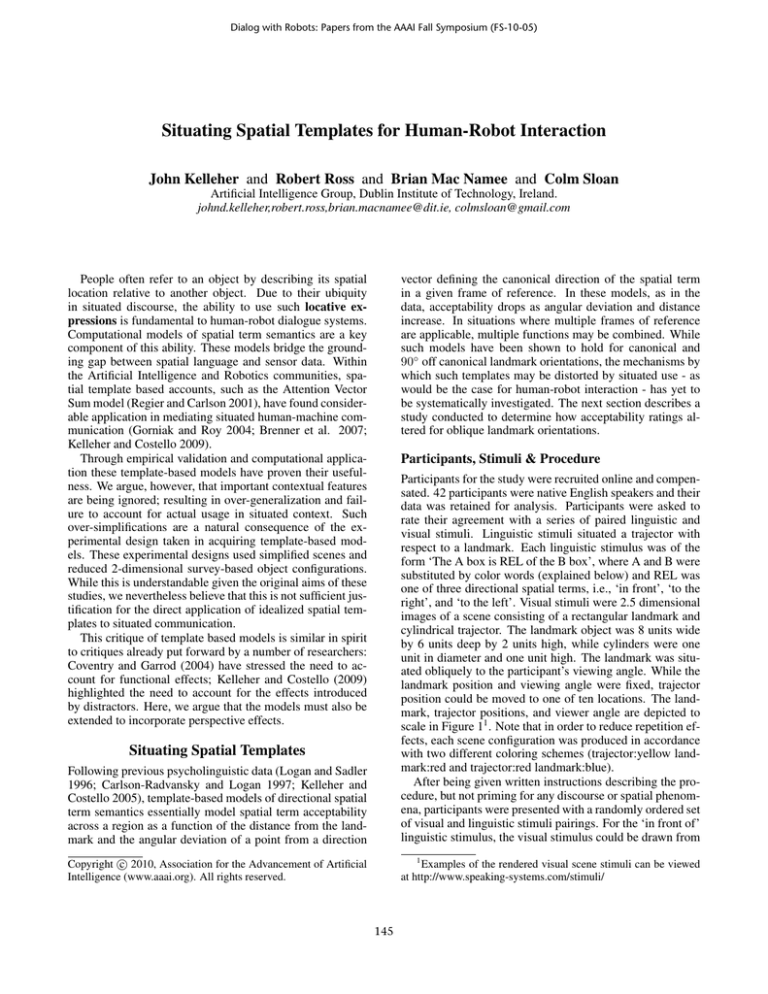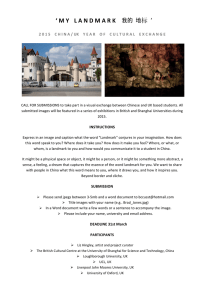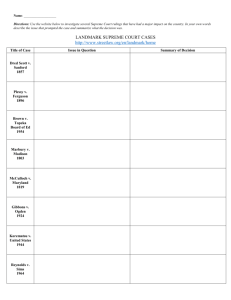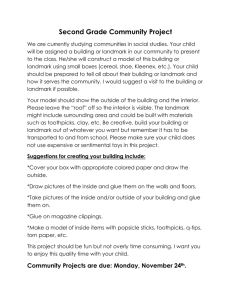
Dialog with Robots: Papers from the AAAI Fall Symposium (FS-10-05)
Situating Spatial Templates for Human-Robot Interaction
John Kelleher and Robert Ross and Brian Mac Namee and Colm Sloan
Artificial Intelligence Group, Dublin Institute of Technology, Ireland.
johnd.kelleher,robert.ross,brian.macnamee@dit.ie, colmsloan@gmail.com
vector defining the canonical direction of the spatial term
in a given frame of reference. In these models, as in the
data, acceptability drops as angular deviation and distance
increase. In situations where multiple frames of reference
are applicable, multiple functions may be combined. While
such models have been shown to hold for canonical and
90◦ off canonical landmark orientations, the mechanisms by
which such templates may be distorted by situated use - as
would be the case for human-robot interaction - has yet to
be systematically investigated. The next section describes a
study conducted to determine how acceptability ratings altered for oblique landmark orientations.
People often refer to an object by describing its spatial
location relative to another object. Due to their ubiquity
in situated discourse, the ability to use such locative expressions is fundamental to human-robot dialogue systems.
Computational models of spatial term semantics are a key
component of this ability. These models bridge the grounding gap between spatial language and sensor data. Within
the Artificial Intelligence and Robotics communities, spatial template based accounts, such as the Attention Vector
Sum model (Regier and Carlson 2001), have found considerable application in mediating situated human-machine communication (Gorniak and Roy 2004; Brenner et al. 2007;
Kelleher and Costello 2009).
Through empirical validation and computational application these template-based models have proven their usefulness. We argue, however, that important contextual features
are being ignored; resulting in over-generalization and failure to account for actual usage in situated context. Such
over-simplifications are a natural consequence of the experimental design taken in acquiring template-based models. These experimental designs used simplified scenes and
reduced 2-dimensional survey-based object configurations.
While this is understandable given the original aims of these
studies, we nevertheless believe that this is not sufficient justification for the direct application of idealized spatial templates to situated communication.
This critique of template based models is similar in spirit
to critiques already put forward by a number of researchers:
Coventry and Garrod (2004) have stressed the need to account for functional effects; Kelleher and Costello (2009)
highlighted the need to account for the effects introduced
by distractors. Here, we argue that the models must also be
extended to incorporate perspective effects.
Participants, Stimuli & Procedure
Following previous psycholinguistic data (Logan and Sadler
1996; Carlson-Radvansky and Logan 1997; Kelleher and
Costello 2005), template-based models of directional spatial
term semantics essentially model spatial term acceptability
across a region as a function of the distance from the landmark and the angular deviation of a point from a direction
Participants for the study were recruited online and compensated. 42 participants were native English speakers and their
data was retained for analysis. Participants were asked to
rate their agreement with a series of paired linguistic and
visual stimuli. Linguistic stimuli situated a trajector with
respect to a landmark. Each linguistic stimulus was of the
form ‘The A box is REL of the B box’, where A and B were
substituted by color words (explained below) and REL was
one of three directional spatial terms, i.e., ‘in front’, ‘to the
right’, and ‘to the left’. Visual stimuli were 2.5 dimensional
images of a scene consisting of a rectangular landmark and
cylindrical trajector. The landmark object was 8 units wide
by 6 units deep by 2 units high, while cylinders were one
unit in diameter and one unit high. The landmark was situated obliquely to the participant’s viewing angle. While the
landmark position and viewing angle were fixed, trajector
position could be moved to one of ten locations. The landmark, trajector positions, and viewer angle are depicted to
scale in Figure 11 . Note that in order to reduce repetition effects, each scene configuration was produced in accordance
with two different coloring schemes (trajector:yellow landmark:red and trajector:red landmark:blue).
After being given written instructions describing the procedure, but not priming for any discourse or spatial phenomena, participants were presented with a randomly ordered set
of visual and linguistic stimuli pairings. For the ‘in front of’
linguistic stimulus, the visual stimulus could be drawn from
c 2010, Association for the Advancement of Artificial
Copyright Intelligence (www.aaai.org). All rights reserved.
1
Examples of the rendered visual scene stimuli can be viewed
at http://www.speaking-systems.com/stimuli/
Situating Spatial Templates
145
However, their acceptance ratings vary and this variation
does not correlate with distance from the landmark. The
same holds for 1A,1B,1C. We posit that this is caused by the
participants’ oblique perspective on the landmark causing a
distortion in the spatial templates for the different frames of
reference.
Conclusions & Future Work
In Human-Robot dialogue systems spatial template models
bridge the grounding gap between spatial language and sensor data. To date, however, the effect of interlocutor perspective on spatial templates has not been systematically examined. To this end, we conducted an experiment where the
landmark object was presented at an oblique angle to the participants. We interpret our results to indicate that interlocutor perspective on a landmark may distort directional spatial
templates anchored on the object. While this is not in itself
a surprising result, it does highlight an issue with current
template-based accounts of spatial term semantics; namely,
that these models focus on the geometric relationships between the trajector and the landmark and largely omit interlocutor perspective as a feature. As such they are incomplete. In future work we aim to take the computational models used by robotic systems and move them towards these
more complete accounts.
Figure 1: The configurations used in the visual stimuli.
Table 1: Mean acceptance ratings for stimuli with standard
deviations: 0 = Strong disagreement. 6 = Strong agreement.
Front
Right
Left
Position Mean
sd Mean
sd Mean
sd
1a
2.96 1.81
4.04 1.50
1b
2.93 1.74
3.87 1.65
1c
3.22 1.80
4.43 1.53
2
2.41 1.82
4.83 1.40
3
1.52 1.38
4.54 1.62
4a
4.43 1.46
3.26 1.91
4b
3.91 1.67
3.39 1.84
4c
4.28 1.68
4.26 1.73
5
2.63 1.78
4.57 1.49
6
1.48 1.41
4.85 1.28
-
References
Brenner, M.; Hawes, N.; Kelleher, J.; and Wyatt, J. 2007.
Mediating between qualitative and quantitative representations for task-orientated human-robot interaction. In Proc. of
the 20th Int. Joint Conference on Artificial Intelligence.
Carlson-Radvansky, L., and Logan, G. 1997. The influence
of reference frame selection on spatial template construction. Journal of Memory and Language 37:411–437.
Coventry, K. R., and Garrod, S. C. 2004. Saying, seeing and
acting. The psychological semantics of spatial prepositions.
Essays in Cognitive Psychology series. Psychology Press.
Gorniak, P., and Roy, D. 2004. Grounded semantic composition for visual scenes. Journal of Artificial Intelligence
Research 21:429–470.
Kelleher, J., and Costello, F. 2005. Cognitive representations
of projective prepositions. In Proc. of the 2nd Workshop on
The Linguistic Dimensions of Prepositions and their Use in
Computational Linguistics Formalisms and Applications.
Kelleher, J. D., and Costello, F. J. 2009. Applying computational models of spatial prepositions to visually situated
dialog. Computational Linguistics 35(2):119–149.
Logan, G. D., and Sadler, D. D. 1996. A computational
analysis of the apprehension of spatial relations. In Bloom,
P.; Peterson, M. A.; Nadel, L.; and Garrett, M. F., eds., Language and Space. Cambride, MA: MIT Press. 493–530.
Regier, T., and Carlson, L. A. 2001. Grounding spatial language in perception: An empirical and computational investigation. Journal of Experimental Psychology: General
130(2):273–298.
any possible trajector position. For the ‘to the right of’ and
’to the left of’ linguistic stimulus, the visual stimulus was
limited to location sets 4, 5, 6 and 1, 2, 3 respectively. For
each stimulus pairing, participants were required to indicate
their level of agreement through a 7 point Likert scale. Each
participant rated each applicable visual stimulus for each linguistic stimulus, and color schemes for each pairing were
selected randomly from the available pairings.
Results & Analysis
Table 1 presents the mean acceptance ratings and standard
deviations for each stimulus pairing. As a control test of
participant understanding, we expected, and found, high ratings for trajector positions 2 and 3 for stimuli including ‘to
the left’, and high ratings positions 5 and 6 for stimuli including ‘to the right’. Also expected and found, was that
participants rated the acceptability of ‘in front of’ higher for
positions oriented with the long face of the landmark higher
than the short face (compare set 1 and 4). We attribute this
to the effect of the landmark’s intrinsic frame of reference.
In comparison with (Logan and Sadler 1996; CarlsonRadvansky and Logan 1997; Kelleher and Costello 2005),
however, there are some anomalies in our data. Most striking is the fact that the acceptability ratings do not systematically drop with angular deviation from any plausible direction vectors, nor with distance from the landmark. For
example, 4A,4B,4C have the same angular deviation from
both the intrinsic and the viewer-centered direction vectors.
146







